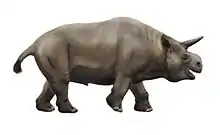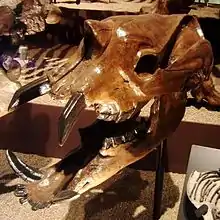Meridiungulata
Meridiungulata is an extinct clade with the rank of cohort or superorder, containing the South American ungulates Pyrotheria (possibly including Xenungulata), Astrapotheria, Notoungulata and Litopterna. It is not known if it is a natural group; it is known that both Litopterna and Notoungulata form a clade based on collagen evidence, but the placement of the other members is uncertain. it was erected to distinguish the ungulates of South America from other ungulates. Relationships between the orders inside Meridiungulata remain unresolved and it could well be a "wastebasket taxon". Most Meridiungulata died out following the invasion of South America by North American ungulates and predators during the Great American Interchange,[1][2][3] but a few of the largest species of notoungulates and litopterns survived until the end-Pleistocene extinctions. The notoungulate Mixotoxodon was able to invade North America to as far as present-day Texas.[4]
| Meridiungulata | |
|---|---|
 | |
| Restoration of Hoffstetterius imperator, a Notoungulate | |
.jpg.webp) | |
| Restoration of Macrauchenia patagonica, a Litoptern | |
| Scientific classification | |
| Kingdom: | Animalia |
| Phylum: | Chordata |
| Class: | Mammalia |
| Clade: | Laurasiatheria |
| (unranked): | †Meridiungulata McKenna 1975 |
| Orders | |
| |
Taxonomy
Meridiungulata might have originated in South America from a North American condylarth ancestor,[5] and they may be members of the clade Laurasiatheria, related to other ungulates, including artiodactyls and perissodactyls.[6] It has, however, been suggested the Meridiungulata are part of a different macro-group of placental mammals called Atlantogenata.[7]
Much of the evolution of meridiungulates occurred in isolation from other ungulates, a great example of convergent evolution. However, the argument that meridiungulates are related to artiodactyls and perissodactyls needs support from molecular sequencing. Some paleontologists have also challenged the monophyly of Meridiungulata by suggesting that the pyrotheres are more closely related to other mammals, such as Embrithopoda (an African order possibly related to elephants), than to other South American ungulates.[8]
Results from the sequencing of collagen from Pleistocene fossils of the notoungulate Toxodon and the litoptern Macrauchenia have indicated that at least these two orders are indeed laurasiatheres, and form a sister group to odd-toed ungulates.[9][10] This result has been corroborated with mitochondrial DNA extracted from Macrauchenia, which points towards a branching date of 66 million years ago.[11] Panperissodactyla has been proposed as the name of an unranked clade to include perissodactyls and their extinct South American ungulate relatives.[9]
Classification

The following classification is from Rose 2006:
- †Meridiungulata
- †Didolodus (incertae sedis)
- †Eoastrapostylops
- †Amilnedwardsia (Notopterna?)
- Order †Notoungulata
- Suborder †Notioprogonia
- Suborder †Toxodontia
- Suborder Typotheria
- Suborder Hegetotheria (Typotheria?)
- Order †Litopterna (Panameriungulata)
- †Protolipternidae
- †Notonychopidae (Notopterna?)
- †Macraucheniidae
- †Adianthidae
- †Proterotheriidae
- Order †Astrapotheria
- †Eoastrapostylopidae
- †Trigonostylopidae (Trigonostylopoidae?)
- †Astrapotheriidae
- Order †Pyrotheria
- †Colombitheriidae
- †Pyrotheriidae
- Order †Xenungulata
Notes
- Webb, S. D. (1976). "Mammalian Faunal Dynamics of the Great American Interchange". Paleobiology. 2 (3): 220–234. doi:10.1017/S0094837300004802. JSTOR 2400220.
- Marshall, L. G.; Cifelli, R. L. (1990). "Analysis of changing diversity patterns in Cenozoic land mammal age faunas, South America". Palaeovertebrata. 19: 169–210. Retrieved 2018-10-08.
- Webb, S. D. (1991). "Ecogeography and the Great American Interchange". Paleobiology. 17 (3): 266–280. doi:10.1017/S0094837300010605. JSTOR 2400869.
- Lundelius et al. 2013
- Muizon & Cifelli 2000
- Hunter & Janis 2006
- Naish 2008
- Shockey & Anaya 2004
- Welker et al. 2015
- Buckley 2015
- Westbury et al. 2017
References
- Buckley, M. (2015-04-01). "Ancient collagen reveals evolutionary history of the endemic South American 'ungulates'". Proceedings of the Royal Society B: Biological Sciences. 282 (1806): 20142671. doi:10.1098/rspb.2014.2671. PMC 4426609. PMID 25833851.CS1 maint: ref=harv (link)
- Hunter, J.P.; Janis, C.M. (2006). "Spiny Norman in the Garden of Eden? Dispersal and early biogeography of Placentalia". Journal of Mammalian Evolution. 13 (2): 89–123. doi:10.1007/s10914-006-9006-6. OCLC 4669969299. S2CID 41292696.CS1 maint: ref=harv (link)
- McKenna, M.C. (1975). "Toward a phylogenetic classification of the Mammalia". In Luckett, W.P.; Szalay, F.S. (eds.). Phylogeny of the primates: a multidisciplinary approach (Proceedings of WennerGren Symposium no. 61, Burg Wartenstein, Austria, July 6–14, 1974. New York: Plenum. pp. 21–46. doi:10.1007/978-1-4684-2166-8_2. ISBN 978-1-4684-2168-2.CS1 maint: ref=harv (link)
- Muizon, C. de; Cifelli, R.L. (2000). "The "condylarths" (archaic Ungulata, Mammalia) from the early Paleocene of Tiupampa (Bolivia): implications on the origin of the South American ungulates". Geodiversitas. 22 (1): 47–150. Retrieved 30 June 2017.CS1 maint: ref=harv (link)
- Lundelius, E. L.; Bryant, V. M.; Mandel, R.; Thies, K. J.; Thoms, A. (2013). "The first occurrence of a toxodont (Mammalia, Notoungulata) in the United States". Journal of Vertebrate Paleontology. 33 (1): 229–232. doi:10.1080/02724634.2012.711405. hdl:1808/13587. S2CID 53601518.CS1 maint: ref=harv (link)
- Naish, Darren (2008-02-08). "Snorki the giant's friends and relatives". Tetrapod Zoology. Archived from the original on 21 May 2013. Retrieved 2014-10-07.CS1 maint: ref=harv (link)
- Rose, Kenneth David (2006). The beginning of the age of mammals. Baltimore: JHU Press. ISBN 978-0801884726.CS1 maint: ref=harv (link)
- Shockey, B.J.; Anaya, F. (2004). "Pyrotherium macfaddeni, sp. nov. (late Oligocene, Bolivia) and the pedal morphology of pyrotheres". Journal of Vertebrate Paleontology. 24 (2): 481–488. doi:10.1671/2521. S2CID 83680724.CS1 maint: ref=harv (link)
- Welker, F.; Collins, M. J.; Thomas, J. A.; Wadsley, M.; Brace, S.; Cappellini, E.; Turvey, S. T.; Reguero, M.; Gelfo, J. N.; Kramarz, A.; Burger, J.; Thomas-Oates, J.; Ashford, D. A.; Ashton, P. D.; Rowsell, K.; Porter, D. M.; Kessler, B.; Fischer, R.; Baessmann, C.; Kaspar, S.; Olsen, J. V.; Kiley, P.; Elliott, J. A.; Kelstrup, C. D.; Mullin, V.; Hofreiter, M.; Willerslev, E.; Hublin, J.-J.; Orlando, L.; Barnes, I.; MacPhee, R. D. E. (2015-03-18). "Ancient proteins resolve the evolutionary history of Darwin's South American ungulates". Nature. 522 (7554): 81–84. doi:10.1038/nature14249. ISSN 0028-0836. PMID 25799987. S2CID 4467386.CS1 maint: ref=harv (link)
- Westbury, M.; Baleka, S.; Barlow, A.; Hartmann, S.; Paijmans, J. L. A.; Kramarz, A.; Forasiepi, A. M.; Bond, M.; Gelfo, J. N.; Reguero, M. A.; López-Mendoza, P.; Taglioretti, M.; Scaglia, F.; Rinderknecht, A.; Jones, W.; Mena, F.; Billet, G.; de Muizon, C.; Aguilar, J. L.; MacPhee, R. D. E.; Hofreiter, M. (2017-06-27). "A mitogenomic timetree for Darwin's enigmatic South American mammal Macrauchenia patachonica". Nature Communications. 8: 15951. doi:10.1038/ncomms15951. PMC 5490259. PMID 28654082.CS1 maint: ref=harv (link)